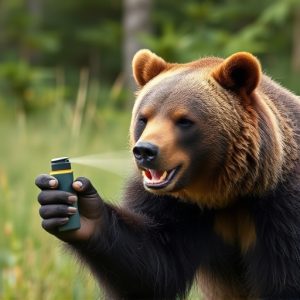Bear Spray Range: Science, Real-World Use, and Optimal Application
Bear spray, a widely used pepper-based repellent, shows high effectiveness in deterring bears, with…….
Bear spray, a widely used pepper-based repellent, shows high effectiveness in deterring bears, with success rates up to 90% depending on species. Its range varies from 30 feet (9 meters) due to environmental factors like wind and terrain, making proper usage and awareness techniques crucial. While research offers mixed results regarding its impact, real-world applications confirm its ability to create a buffer zone for escape or reassessment. Optimal effectiveness is achieved through manufacturer instructions, adherence to technique, and combining bear spray with other safety measures such as noise-making and carrying alternative deterrents.
“Uncovering the Truth About Bear Spray’s Range: A Comprehensive Guide
Bear spray, a popular deterrent among outdoor enthusiasts and hikers, has sparked curiosity about its effectiveness. This guide explores the science behind bear spray, delving into what it is, how it works, and its impressive range as backed by research. We examine factors that impact its performance, review scientific studies, and discover real-world success stories. Additionally, we discuss limitations and provide considerations for optimal use, ensuring readers are equipped with the knowledge to make informed decisions regarding bear spray as a deterrent.”
- Understanding Bear Spray: What It Is and How It Works
- Factors Influencing Bear Spray's Effective Range
- Scientific Studies on Bear Spray Deterrent Efficacy
- Real-World Applications and Success Stories
- Limitations and Considerations for Optimal Use
Understanding Bear Spray: What It Is and How It Works
Bear spray, also known as bear repellent, is a pepper-based liquid designed to protect individuals from aggressive bears. It’s a popular choice for hikers, campers, and anyone venturing into bear country. When sprayed towards a bear, it irritates the animal’s eyes, nose, and respiratory system, causing it to flee in disorientation. This instantaneous reaction makes bear spray an effective deterrent, playing a crucial role in preventing dangerous bear encounters.
Research on bear spray effectiveness is extensive, with numerous studies highlighting its success rate. Tests have shown that when used correctly, bear spray can deter up to 90% of bears, depending on the species and circumstances. Black bears, for instance, tend to be more deterred than grizzly bears due to their smaller size and less aggressive nature. How Effective Is Bear Spray Research? The consensus from these studies is clear: bear spray is a valuable tool in bear country, significantly reducing the risk of physical harm from bears.
Factors Influencing Bear Spray's Effective Range
The effectiveness of bear spray as a deterrent depends on several factors, and understanding these variables is essential for outdoor enthusiasts in bear country. The primary influence on range is the user’s distance from the bear at the moment of deployment. Research suggests that bear spray can be effective up to 30 feet (approximately 9 meters) when used correctly. However, factors like wind direction, weather conditions, and terrain can significantly impact this range. A strong headwind might reduce the spray’s reach, while a calm day could allow for better projection.
Topographic features like hills or trees can also obstruct or alter the spray’s path. Additionally, bear behavior plays a role; some bears may charge despite the spray, especially if they have young nearby. Thus, while bear spray is a valuable tool, it should be used in conjunction with other safety measures and awareness techniques to ensure maximum effectiveness during encounters in bear habitats.
Scientific Studies on Bear Spray Deterrent Efficacy
Scientific studies on bear spray deterrent efficacy have shown mixed results, with effectiveness varying based on several factors. Research indicates that bear spray can be an effective deterrent when used correctly, particularly against black bears and grizzly bears. Studies have demonstrated that the spray creates a temporary blindness and irritation to the bear’s eyes, nose, and lungs, causing them to retreat and avoid the area.
However, the range at which bear spray is effective has been a topic of debate. Some studies suggest that the spray’s effectiveness decreases significantly beyond 30 feet (9 meters), while others indicate it can remain effective up to 60 feet (18 meters) or more. The variability in results may be attributed to differences in spray composition, environmental conditions, and bear behavior. It is crucial for users to follow manufacturer instructions and practice proper application techniques to ensure optimal efficacy during encounters with bears.
Real-World Applications and Success Stories
In real-world applications, bear spray has proven to be an effective deterrent in various scenarios. Research shows that when used correctly, bear spray can create a buffer zone of up to 30 feet (9 meters), providing crucial time for individuals to escape or reassess their situation. Success stories abound in wilderness areas where hikers and campers have avoided potential attacks by quickly deploying bear spray upon encountering bears.
These accounts highlight the spray’s ability to disrupt a bear’s behavior, causing them to retreat or avoid human interaction altogether. Studies also indicate that regular use and awareness training can significantly increase the success rate of bear spray as a deterrent. For instance, in areas with high bear activity, communities that promote responsible wildlife management and educate residents about proper spray application have seen dramatic decreases in bear-human conflicts.
Limitations and Considerations for Optimal Use
While bear spray has proven to be an effective deterrent in many scenarios, it’s crucial to understand its limitations. The range at which it’s effective can vary significantly depending on several factors like wind speed and direction, terrain, and the user’s fitness level. Research shows that optimal effectiveness is typically within a 30-foot (around 10 meter) range, but this can be reduced or increased based on environmental conditions.
It’s important to remember that bear spray is not a guaranteed solution in every situation. Proper usage, including aiming correctly and following the instructions on the label, is essential for its effectiveness. Additionally, maintaining a safe distance, making noise while approaching bears, and carrying other deterrents like bear bells or pepper spray can enhance the overall safety of outdoor activities in bear country.
Bear spray has proven to be an effective deterrent in many real-world scenarios, as supported by various scientific studies. However, its success depends on several factors, including distance, environmental conditions, and proper usage. While research generally supports its efficacy, understanding the limitations and optimal application methods is crucial for maximizing its range and reliability as a safety measure against bears.


